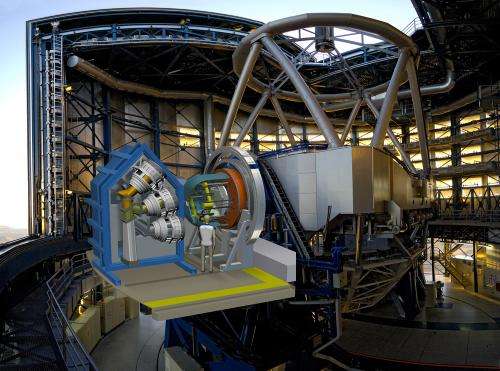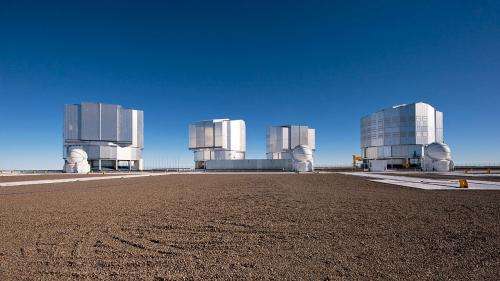Artist's impression of the MOONS instrument. Credit: STFC
A €9M contract is announced today for UK-based engineers and designers to build a unique and powerful instrument that aims to tackle some of the most compelling astronomical puzzles – such as how stars and galaxies form and evolve, and probing the structure of our own Milky Way.
A project team from the UK Astronomy Technology Centre (UK ATC) in Edinburgh will lead this international project to develop and build MOONS for the European Southern Observatory's (ESO) Very Large Telescope (VLT) in northern Chile, already the world's most productive ground-based astronomical facility.
MOONS (Multi-Object Optical and Near-infrared Spectrograph) will allow astronomers to see obscured areas in the Milky Way at a distance of around 40,000 light years away, and enable them to create a 3D map of our galaxy. This is difficult to do as the Earth is in the middle of the Milky Way's disc, so the process is like trying to map a forest of densely-packed trees from the inside.
Director of the UK ATC, Professor Gillian Wright, said "The team at UK ATC in Scotland have an opportunity with this project to enable all of us to understand why the Milky Way looks the way it does. This instrument will act as an intergalactic GPS to help us to navigate through the billions of stars in our galaxy and create a comprehensive map of its structure."
Conceived at the UK ATC – part of the Science and Technology Facilities Council (STFC) – MOONS is scheduled to become operational by 2019. Building such an ambitious and powerful new device – which will be about the size of a transit van – will take around 200 staff-years of effort, with the hardware alone costing €9M. The full project will cost around €23M. The UK ATC will lead the Project Office managing the multinational consortium that will construct MOONS, and will also play a vital design role for key components and ensure the project's benefits extend throughout UK industry.
The VLT platform. (Credit: ESO
Like any spectrograph, MOONS will use the colour of light emitted by objects to reveal their chemical composition, mass, speed and other properties. Breaking new ground by simultaneously observing 1000 objects using fibre-optic cables to feed their visible and infrared light into the instrument, it will survey large samples of objects far faster than any existing instrument and conduct surveys that would be virtually impossible using today's technologies. Not surprisingly, the design will pose extraordinary technical demands. For example, each of the 1000-plus fibres will have to move into position very quickly, with great accuracy and without colliding with each other.
In collaboration with the University of Cambridge and other UK universities, the UK ATC's world-leading expertise in fields such as miniaturised mechanics and precision optics will be harnessed on key aspects of the project. The UK ATC will develop the most innovative component, the individual motorised systems allowing each fibre to move rapidly into position; it will also develop the cryostat system (used to cool MOONS down to -170°C) vital to enabling the infrared observations needed to penetrate galactic and intergalactic dust clouds. The University of Cambridge will develop complex cameras capable of meeting the instrument's demanding performance requirements.
Partnerships with a range of UK equipment suppliers will also contribute across the project, helping the UK to further strengthen its cutting-edge scientific capabilities in the relevant fields.
Once MOONS is up and running, the international consortium will receive 300 nights of observations using the instrument. In particular, this will benefit two ground-breaking projects: one to produce an unprecedented sophisticated survey of the centre of the Milky Way; the other to look far back in time at ultra-distant galaxies to uncover the secrets of their early evolution. For more information, visit the ROE website.
Dr Michele Cirasuolo of the UK ATC, Principal Investigator on the project, says: "MOONS is a unique instrument able to pioneer a wide range of galactic, extragalactic and cosmological studies and provide crucial follow-up for major facilities such as Gaia, the Visible and Infrared Survey Telescope for Astronomy (VISTA), Euclid and the Large Synoptic Survey Telescope (LSST). I am hugely proud of the dedication and skill demonstrated over the project's selection stages by our engineers and scientists at the UK ATC and across the consortium. We look forward to building this exceptional piece of technology and paving the way for many discoveries."
Professor Roberto Maiolino from the University of Cambridge, Project Scientist for MOONS, says: "MOONS will vastly expand our knowledge of the mechanisms responsible for galaxy evolution across the life of the Universe. It will be possible to characterise the properties of millions of distant galaxies – for instance, by identifying the signatures of ongoing star formation and black hole accretion – and how galaxies' evolution depends on their large-scale environment. Cambridge will play an essential role designing and assembling key optical subsystems, as well as in defining the science programme."
Provided by Science and Technology Facilities Council
























